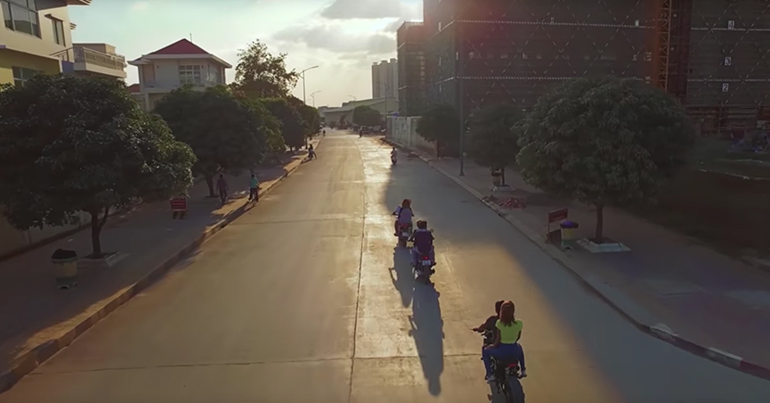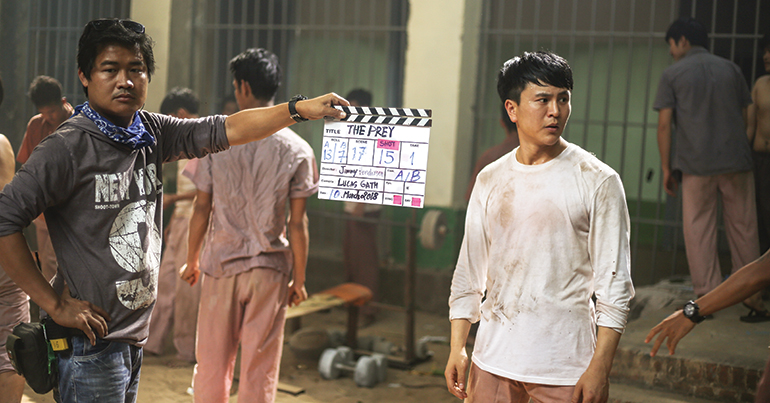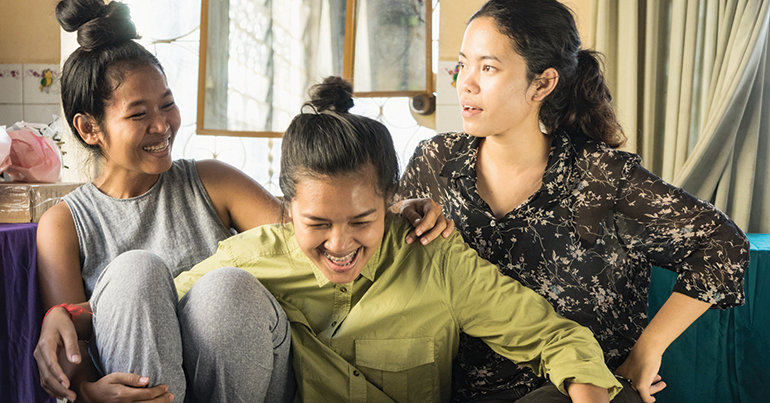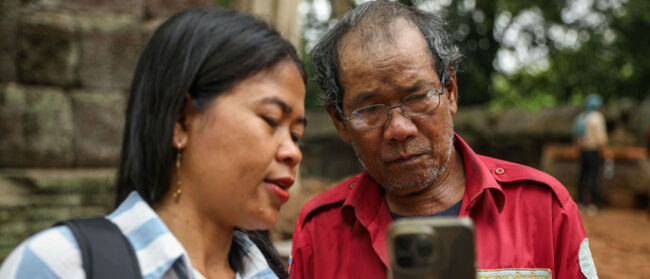Clad in high-vis neon and with police on hand, a group of Cambodian filmmakers is setting up a midnight shot on an unassuming stretch of the enormous Hun Sen Boulevard that heads south out of Phnom Penh. The occasional car, truck or motorbike thunders past at breakneck speed, lit by the huge street lamps that dot the side of the road as far as the eye can see. And as the crew of Cambodian director Kavich Neang’s newest short film gather around a roadside food stall prop, only a few notice a truck hurtling along, heading straight towards them. With not a few screams and shouts as the crew rushes to dodge it, the truck stops short at what feels like inches away. After many laughs, business continues as usual.
This is the dramatic reality of late-night shoots for a new breed of Cambodian filmmakers giving a fresh face to the industry. Once dominated by low-budget commercial flicks and Khmer Rouge retellings, Cambodia – a country with no formal film school – is seeing an upswing of raw new voices, local and foreign, that are daring to do something new.
“[There is], I think, a special spirit, a special vibe that you can feel at the shooting, which sometimes is told to me from outsiders – somehow here, maybe the feeling, the intuition, that they are doing something for the first time,” Davy Chou, a French-Cambodian director who’s helping out on set, told Southeast Asia Globe earlier that day under slightly less stressful circumstances, cross-legged on a sofa of one of the crew members’ homes, which has been turned into an office for the day.

Chou is a co-founder of Anti-Archive, a Phnom Penh-based film production company launched in 2014 that focuses on nurturing a new generation of independent filmmaking talent in the country. Alongside fellow co-founders Neang, Taiwanese-American Steve Chen and South Korean Park Sungho, the Anti-Archive team have been behind some of the country’s recent film successes, most notably Davy Chou’s debut feature film and coming-of-age story Diamond Island, which won the SACD prize at Cannes Film Festival International Critics’ Week in 2016.
“I think it’s a kind of special time and people are aware of it,” said Chou. “Things are changing – more and more directors, more films, interest from the industry to invest in films. But more important than that, I think a real desire from younger people to make films and to consider working in the film industry. Now, with movie theatres, film festivals, also just basically cameras available to be rented and film crews, things are really changing.”
In a seemingly quieter corner of the city, a different, more sizable crew have set up shop. Overlooking the Tonlé Sap river, the now-demolished Kien Khleang Orphanage Centre in Phnom Penh’s Chroy Changvar district has become the sight of a fearsome clash between prisoners. In a cloud of dust and smoke, the 30-plus extras all clad in purple, most never having acted before, are locked in an all-out brawl in its central courtyard, a gentle light streaming through a canopy of trees to form delicate shadows on the prison bars and walls.
“So the question is not really can we find the success, [but] can we find the money to be able to make it happen.”
Davy Chou, filmmaker
This is the set of the Italian Jimmy Henderson’s new film The Prey – capitalising on the success of his 2017 Cambodian action debut Jailbreak, by all accounts the first action feature film in the country and one of the first local productions to be made available on Netflix. Henderson and his team have their sights set even higher for their new production. An all-star international cast – Chinese national boxing champion Gu Sheng Wei plays the lead role as an undercover policeman, internationally known Thai actor Vithaya Pansringarm plays a prison warden and Jailbreak’s Cambodian actors Dara Our and Dy Sonita return for a second time – making the film trilingual. Henderson explained how, unlike Jailbreak, they are directly targeting foreign markets, the first local production to do so.
“This allows the industry to grow,” he said. “People start paying more attention. You have more investors coming in to make films here, and then you create more employment, [and] with more employment you create more knowledge. If you’re stuck just doing the very low-budget [films], the industry will stay where it is. The mission is to prove [ourselves] to the outside – we have the technical skills to do this, and then everything else will grow.”

The goal is to make a film that will appeal to Thai and especially Chinese sentiments, said Henderson. China’s film market is the second biggest in the world, after Hollywood. “We hope big,” he said. “[It] would be the first Cambodian film ever to show theatrically in China.”
For the Prey team, the marketing of the film will be just as big a beast as the production side of things. Working within an industry that for years has been restricted to formulaic horror or comedy films – proven successes among Cambodian audiences – very deliberate marketing choices ensured that Jailbreak would still have some commercial appeal.
“This is our approach,” said Henderson. “We thought about how we [could] break into the market with an action movie. So we started adding more comedy and we started thinking about gathering stars, local comedians that the people know… The idea really was to make something different, to push the industry in a different direction.”
“It’s not [always] related to budget – there are ways to be smart, to engage with your audience, to get people excited.”
Loy Te, producer
For filmmakers in Cambodia, it becomes necessary to build trust between not only filmmaker and investor – to prove that their product is commercially viable – but filmmaker and cinemagoer, to encourage them to accept something new and different. This is a marketing point that other local productions, especially those that have tried but failed to emulate Jailbreak’s formula and success, are yet to come to grips with, said Loy Te, producer of both The Prey and its predecessor.
“There’s been quite a bit of a trend of local productions complaining that the audience don’t support [them] and prefer to go watch the latest Avengers or something like that,” he said. “I think that if they work on [having] a stronger appeal, trying to connect more with the audience, it could have a much stronger impact. And it’s not related to budget – there are ways to be smart, to engage with your audience, to get people excited.”
Their new film will now present a whole wealth of different challenges, said Henderson. “I don’t know about the reaction of the people,” he said. “[They might question] why people speak Thai in the movie. It’s a tricky one. We’re still figuring it out. We’re using our brand to show something very good can be done here, but there is a little bit of cultural conflict, I think.”
This concern for marketing and popular appeal is further from Davy Chou and Anti-Archives’ field of vision. They believe artistic expression is a goal in itself and that the bourgeoning of an independent film scene should grow alongside the commercial industry. “I think it’s already a big goal,” said Chou. “[We have an] intuition that there are voices here to be expressed but cannot be fully expressed in the commercial environment. We really give them the freedom of… doing what they want to do. So the question is not really can we find the success, [but] can we find the money to be able to make it happen.”

Anti-Archives launched the Echoes From Tomorrow project in 2017 to support this kind of budding talent in the country by helping three first-time directors produce their first short films. Foreseeing the difficulty in attracting investment for the commercially unviable format of short films, they looked to crowdfunding, through which they managed to raise over $24,000 in two weeks, $10,000 more than their original target. And although not a conscious choice, according to Chou, having what ended up being three women as the faces of the project was a refreshing and symbolic sign of the industry moving forward. Meas Sreylin, San Danech and Tith Kanitha, who have all worked in a number of production roles for previous Anti-Archive films – common for those working in a country with no professional film school – became the first female directors at the production company.
Tith told Southeast Asia Globe she does not see any creative barriers for female filmmakers in Cambodia. “If you are a girl, you are a man, you are a kid, whatever, you have the ability to create,” she said. “But then, of course, we cannot deny that when we grow up, we are formed by tradition, we are formed by our family, we are formed by the culture [that] surrounds us… I don’t deny that there are some barriers, but when you come to create something, there’s no barrier because it’s your own thing and you create your own story.”
For both Henderson and Chou, the development of the industry in Cambodia is intimately linked with moving away from genre flicks, but also the crafting of an international image of a country no longer plagued by war – of a booming, developing society that is launching itself into the future.
“It’s a question of representation, which [is what] art is all about,” said Chou. This could be the dramatics of a prison brawl or simply a young Khmer boy buying a bottle of water on an empty stretch of highway. “A different representation, to provide different perspectives and realities, history, female voices and female perspectives on the same society – that’s what art and cinema is about for sure.”


